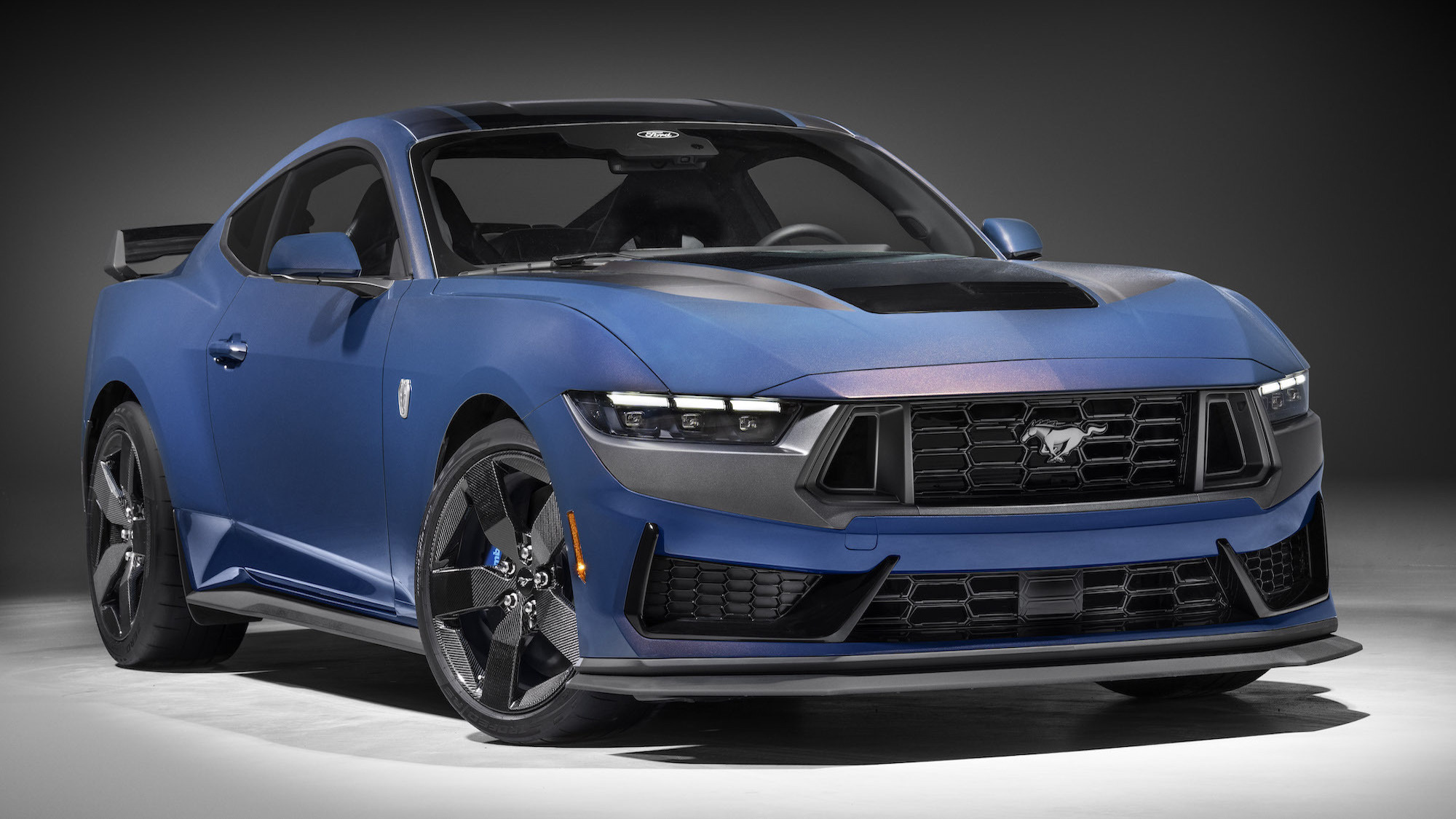

Ford’s 2024 Mustang Dark Horse is the automaker’s turn-it-up-to-11 version of its iconic muscle car. With a powerful 5.0-liter engine cranking out 500 horsepower, this iteration of the seventh-generation Mustang is made for speed, and for track enthusiasts. It’s packed with goodies like an interactive digital interface in the cabin along with special ducts to keep the Brembo performance brakes cool.
The new Blue Ember metallic paint is available only on the Dark Horse, and the color-shifting blue-to-purple finish evokes a mood ring if your mood is “go fast but be chill about it.” This Mustang features blue-themed Recaro sport seats that sit low inside, and a hollow shift knob crafted from blue lightweight titanium, if you choose the manual transmission option.
But the showstopper is the set of sleek carbon fiber wheels wrapped in track-ready Pirelli P Zero tires. Here’s what these high-tech wheels are all about.
Light, strong rims equals more speed
The Dark Horse is the first performance variant of the Mustang in more than two decades, and Ford opted to equip it with super-light carbon fiber wheels, which are more often spotted on pricey supercars. Ford says it’s the first time a Mustang has worn carbon fiber wheels other than the Shelby GT350 and GT500 (those ended production in 2020 and 2022, respectively), and they look great on the Dark Horse.
Ford partnered with an Australian company called Carbon Revolution for the 19-inch wheels; this is the first time the brand is using five-spoke single-piece carbon-fiber rims.. At a shade over 20 pounds each, these carbon fiber wheels are about 37 percent lighter than the standard aluminum wheels available on the Dark Horse. Less overall weight increases speed, so the wheels take the potential speed of the Mustang up a notch.
Carbon fiber is a polymer, which is a class of materials made of repeating chains of molecules. It’s extremely strong and light, which is why race car builders and supercar companies use it extensively. It’s also expensive, so companies like McLaren invest a fair amount of money to create carbon fiber tubs, which are the frame-like structures on which their cars are made. In fact, the British company spent more than 50 million dollars to build the McLaren Composites Technology Center to create lightweight carbon fiber and composites to save weight and generate more energy-efficient cars.
Mass production automakers like Ford use carbon fiber sparingly to maintain an attractive price point. You’ll see this material surrounding gear shifters, on dashboards, and in door sills, but using it in greater quantities is reserved for a much smaller number of cars. For instance, the one-off Hellucination was built for Ralph Gilles, the lead designer for Stellantis (the parent company for Dodge, Jeep, Chrysler, Alfa Romeo, Fiat, and others), and featured a striking carbon fiber body encasing a supercharged V8. That’s not something you’ll see too often on the street.
A plasma arc spray
Carbon Revolution used a plasma arc spray process on the inside of the front wheels to protect them from brake heat. Inspired by aerospace technology, where it’s often used on turbine engine blades, the plasma arc spray process is also used on open-wheel race cars for durability.
“The process of plasma spraying is when powdered material like metals and ceramics are fed into a plasma flame spraying machine,” explains Carbon Revolution founder and chief technology officer Ashley Denmead. “The process melts the powder with very high temperatures and sprays it at the target part to be coated. The molten powder particles then solidify again when they hit the target and cool down on impact. The coating created for the wheels is multiple layers of different materials. The resultant coating reflects the brake heat away and also prevents conduction of it into the wheel while minimizing the weight penalty.”
This process results in wheels made for driving fast and braking hard, and Ford’s Dark Horse wheels were subject to a slew of testing. Carbon Revolution says it adheres strictly to Ford’s stringent wheel testing criteria, which uses more than 200 tests for structural and environmental validation.
Interestingly, only the front wheels are treated, and Denmead explains to PopSci that it’s not that they forgot about the back wheels. The front brakes generate much more heat, and in the process of testing the team determined with Ford that only the front wheels needed this thermal management.
“During repeated hard driving on track, with a lot of heavy braking it is possible that the brakes would get so hot (up to 1800°F) that they could damage the resin in the wheels,” Denmead says. “This sort of driving would likely far exceed what most people would do even on a track day, but it is important for us and our customers that our high-performance wheels can perform all day long on the track and the road.”
The Dark Horse will be available this summer. Count us in to put it to the test.
